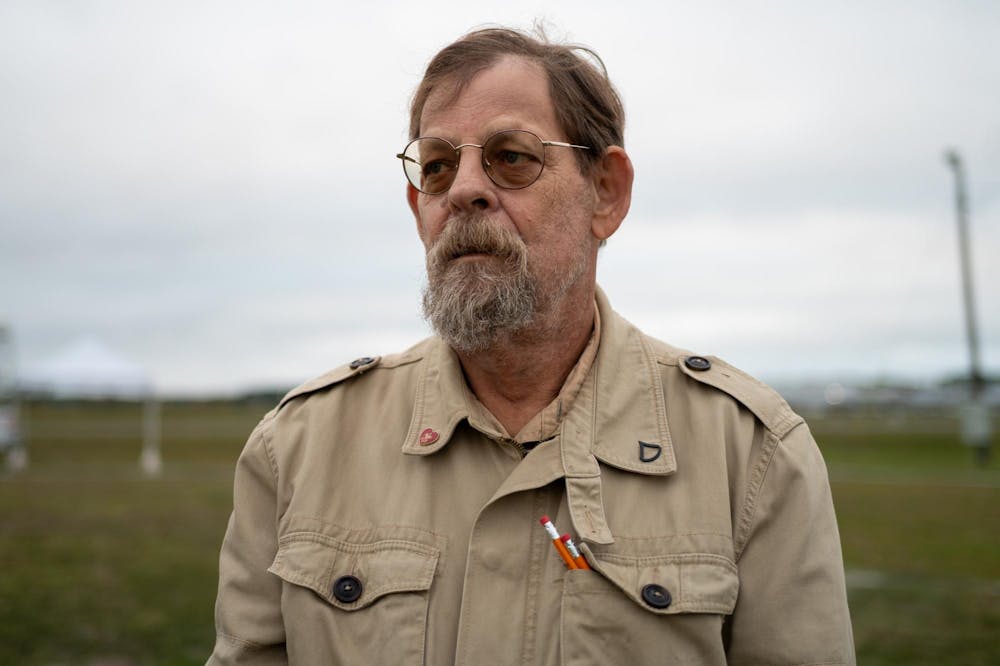John Koch’s colleagues know him by a different name: Dr. Death.
The radio news journalist has witnessed over 100 executions since the start of his career 50 years ago, according to his own count. He documented infamous killer Ted Bundy’s last moments alive and every other death row inmate’s in Florida’s execution chamber since. Now 76, he has no intentions of stopping.
When the state executes people convicted and sentenced to death, it is done on behalf of the people of Florida. Koch views it as his responsibility to let the public know what is happening in their name, he said.
“The people need my voice. They need what I see,” Koch said. “Because it’s up to them. They make the decision to stop these things or not.”
Getting into radio
Koch’s experience with public speaking started at Miami Dade College during the Vietnam War, when he was involved in the anti-war movement.
He had to go into hiding for six months in 1972 after the FBI’s counter-intelligence program, COINTELPRO, targeted the movement, he said.
After re-emerging from the shadows, he met his now-wife and moved to Live Oak, Florida.
In the new city, Koch’s boss at the local drug store told him to get a job at the local news station and called in a favor for him. Koch said he didn’t think anyone would want to hire a “long-haired hippie” like him, but he applied anyway.
Koch walked 23 steps up to the front door of Live Oak’s local radio station, now WQHL, and asked for a job as a photographer, even though he had only used a camera a few times.
While working for the radio station, he met Suwannee County Sheriff Sam St. John, who he has known for over 40 years.
“He kind of stood out,” St. John said of Koch, who donned long hair and a beard paired with a black fedora in his early days of reporting. “He’s the same now as he was 45 years ago.”
Except his hair is shorter now.
Many people describe Koch as “eccentric,” including Suwannee County Supervisor of Elections Jennifer Kinsey, who often serves as a source for Koch’s local reporting projects.
“Very honest, dependable guy, you could just tell he was,” she said. “He’s a little bit different, but we love him to death.”
Koch transitioned to radio a few years later in 1975 and has stuck with it since. He said his struggle with dyslexia made radio the perfect option for him.
“I never felt I was a writer, but I was a speaker,” he said. “I have a way with words.”
His first execution
Koch still produces content for WQHL as a freelancer, but he works independently now so he can report exactly the way he wants.
In 1986, he founded Independent News Services, an online publication, after a disagreement with his boss at the radio station over coverage of a story.
“I didn’t want anybody telling me what to write,” he said. “I didn’t want anybody to have to tell me, ‘that is not what you saw.’ It is so important to me.”
At first, he reported on local news and government activities, and still does. He didn’t start covering executions until 1989, over a decade into his career.
Now, he is a staple at each execution. His wide-brimmed hat and distinctive style can be spotted from 100 yards away.
The first execution he witnessed was Ted Bundy in 1989, the notorious Florida serial killer.
Koch had followed the case since Bundy’s last victim was found in Suwannee County. Bundy had already been arrested for attacking five FSU students a few months before, a crime for which he’d later be sentenced to death.
Koch watched as Bundy’s case went through the courts until it ended up in Orlando in 1980, where Bundy received another death sentence for his last kidnapping and murder.
In 1989, Bundy was executed at the Florida State Prison in Raiford. Koch witnessed it and every execution since, he said.
Koch’s responsibility
Wayne Littrell, a colleague at WQHL and friend of over 40 years, said Koch was different but consistent.
“He’s done a terrific job covering these executions through the years,” he said.
Littrell said Koch is always there ready to cover local events and is the person news stations call when they need someone to cover anything, including executions.
Koch has noticed fewer people attending executions. Protesters are starting to dwindle in numbers, with a noticeable decrease in lawn chairs across from the prison at some of the most recent executions.
The number of reporters covering these executions are dwindling, too. Koch is one of the only old-style radio news reporters left.
“He’s what you imagine a reporter to be when you are a young kid,” said Mike Valente, who met Koch at a recent execution at the prison.
Koch helped Valente get on the media approved list to witness executions and taught him more about the death penalty in Florida.
Rural areas in Florida have few news sources, Koch said, making reporters like him more important than ever to ensure people are getting the news they deserve.
“When I go on the radio, people will listen, people will believe me,” Koch said. “A responsibility that I am keenly aware of.”
Contact Alexa Ryan at aryan@alligator.org. Follow her on X @AlexaRyan_.

Alexa is a second-year journalism and international studies students serving as the Fall 2025 Criminal Justice beat reporter. She previously served as a copy editor. She spends her free time running, traveling, having movie nights and going on random side quests with friends.






